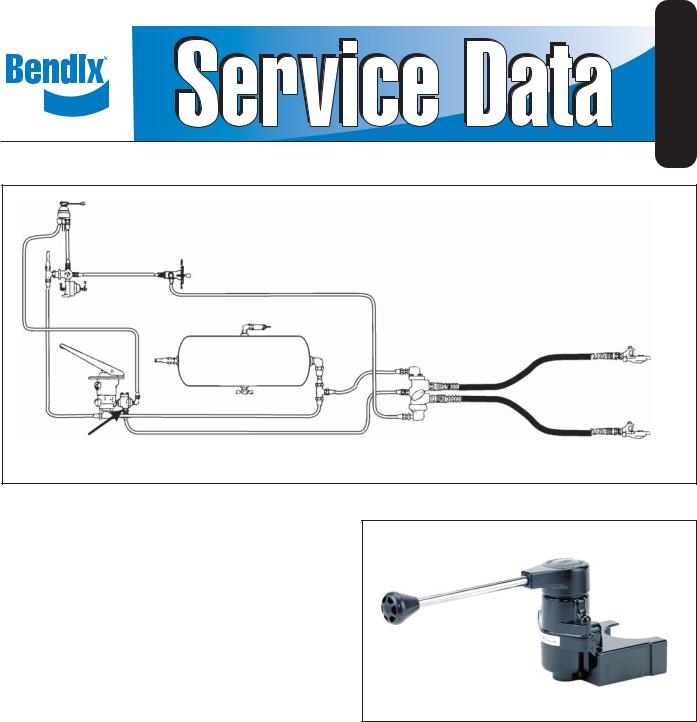Bendix TC-2 TRAILER CONTROL BRAKE VALVE User Manual

|
|
|
SD-03-813 |
Bendix® TC-2™ Trailer Control Brake Valve |
|
|
|
TC-2™ BRAKE |
|
|
|
VALVE |
|
|
|
CONTROL VALVE |
|
|
|
BRAKE |
|
TRACTOR |
EMERGENCY HOSE |
|
PROTECTION |
||
VALVE |
RESERVOIR |
VALVE |
|
|
|
|
|
COMBINATION STOP LIGHT SWITCH |
|
|
SERVICE HOSE |
AND DOUBLE CHECK VALVE |
|
|
|
FIGURE 1 TC-2™ TRAILER CONTROL BRAKE VALVE TYPICAL PIPING DIAGRAM
DESCRIPTION
The TC-2™ brake valve is a hand operated control valve which features a graduated control of air pressure. The most common application is the control of trailer brakes independent of tractor brakes; however, the valve may be remotely operated type valve is connected to the operating handle by a linkage rod.
The TC-2™ brake valve is not intended for use as a parking control valve and should not be used for that purpose.
OPERATION
APPLYING
When the handle or actuating lever is moved in a clockwise direction from the released position, force is exerted on the pressure graduating spring through the action of the cam and cam follower. The force of the spring on the piston causes it to move down.
The exhaust seat, which is in the center of the piston, contacts the exhaust valve and closes the exhaust passage in the piston. The continued downward movement of the piston moves the inlet valve off its seat. Reservoir air pressure flows by the open inlet valve and out the delivery port.
FIGURE 2 EXTERIOR VIEW
HOLDING
The air pressure that flows by the open inlet valve also becomes effective on the bottom area of the piston. As the force of the air pressure beneath the piston balances the force of the depressed graduating spring above, the piston lifts slightly and the inlet valve returns to its seat. The exhaust valve remains seated so the flow of air through the valve is stopped and air pressure in the service line is held.
1
RELEASING
When the handle or operating lever is moved in a counterclockwise direction the force above the piston is decreased. The air pressure beneath will then lift the piston, moving it away from the exhaust valve. With the exhaust passage open, air pressure in the service line will exhaust out the exhaust port of the valve.
PREVENTIVE MAINTENANCE
Important: Review the warranty policy before performing any intrusive maintenance procedures. An extended warranty may be voided if intrusive maintenance is performed during this period.
Because no two vehicles operate under identical conditions, maintenance and maintenance intervals will vary. Experience is a valuable guide in determining the best maintenance interval for any one particular operation.
Visually check for physical damage to the brake valve such as broken air lines and broken or missing parts.
Every 3 months, 25,000 miles or 900 operating hours perform Operating and Leakage Tests.
SERVICE CHECKS
OPERATING TEST
Connect an accurate test gauge to a delivery port. When the handle is moved to the fully applied position, the gauge should register full reservoir pressure. NOTE: Some valves may be preset to deliver lower than reservoir pressure; however, the standard valves generally used on tractors are set to deliver full reservoir pressure. Intermediate positions should deliver proportional intermediate pressures. Upon release, the gauge should immediately register zero.
LEAKAGE TEST
Locate the exhaust port or exhaust line and apply a soap solution. (It is common practice to connect a line from the valve exhaust port to a location remote from the immediate driver’s area.) With the valve in the released position, exhaust leakage should not exceed a 1" bubble in 5 seconds (100 sccm).
With the valve fully applied, leakage at the exhaust should not exceed a 1" bubble in 3 seconds (175 sccm). If the valve does not function as described or leakage is excessive, it is recommended that it be replaced with a new or remanufactured unit, or repaired with genuine parts available at Bendix outlets.
REMOVING AND INSTALLING
REMOVING
1.Block and hold vehicle by means other than air brakes.
2.Drain air brake system.
3.If remote-operated type valve, disconnect the operating mechanism.
4.Disconnect air lines from valve.
5.Remove mounting clamp bolts, clamp, and then valve.
INSTALLING
1.Check and clean air lines to valve.
2.Operating mechanism for remote type should be checked functionally and for proper adjustment.
3.Mount valve with clamp and mounting bolts.
4.Tighten mounting bolts evenly to approximately 200 inch pounds torque (3/8-16 bolt torque 180-220 inch pounds.)
5.If remote type valve, connect operating mechanism.
DISASSEMBLY
HANDLE OPERATED VALVE
1.Drive out the spirol pin and remove the handle, head, and head seal o-ring.
2.Remove handle o-ring.
3.Remote Operated Type Valve: Remove set screw, head and head seal o-ring.
4.Remove adjusting ring lock washer.
5.Remove cap screws that hold body and cover together; separate cover from body.
6.Remove gasket and graduating spring.
7.Remove cam and cam follower from cover.
8.Unscrew and remove adjusting ring.
9.Remove piston and piston return spring from body.
10.Remove piston o-ring.
11.Remove inlet and exhaust insert screws and lock washers, then insert and o-ring seal.
12.The inlet and exhaust valve insert can be disassembled if desired or necessary.
13.Insert some object such as a cap screw in the supply port to hold the inlet valve on its seat.
14.Depress the exhaust valve guide and spring; remove the exhaust valve.
15.Remove stem with inlet valve from inlet seat and remove inlet valve from stem.
CLEANING AND INSPECTION OF PARTS
1.Clean all metal parts in mineral spirits.
2.Wipe rubber parts clean.
3.Inspect valve seats for nicks or burrs.
4.Check all springs for distortion, cracks, and corrosion.
5.All rubber parts should be inspected for wear or deterioration.
6.Replace all parts not considered serviceable during their inspection with genuine Bendix replacement parts.
2
